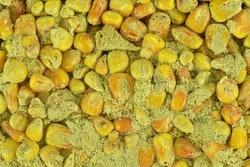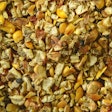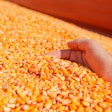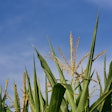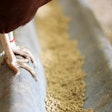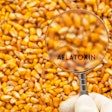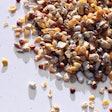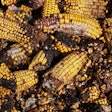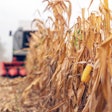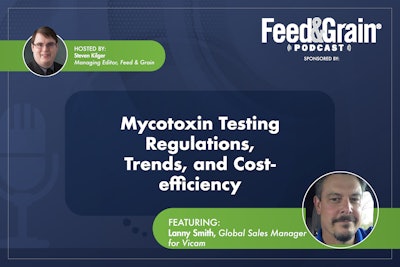
In this podcast episode, Steven Kilger, the host of the Feed & Grain Podcast, interviews Lanny Smith, the Global Sales Manager for Vicam. The discussion delves into mycotoxin testing and its implications for feed manufacturing, grain handling, and related industries. The conversation covers topics such as regulatory oversight, international standards, and the challenges of mycotoxin contamination. Lanny explains the importance of mycotoxin testing, particularly focusing on aflatoxin and other mycotoxins, and the need for organizations to proactively address contamination. The conversation also touches on emerging trends and advancements in mycotoxin management, highlighting the evolution of technology and its increasing accessibility for on-site testing.
Steven Kilger: Hello everyone. My name is Steven Kilger. I'm the managing editor for Feed & Grain and the host of the Feed & Grain Podcast. Thank you so much for joining me today as we take a deep dive into the issues affecting feed manufacturing, grain handling and all the allied industries that we work with.
Today, I'm speaking with Lanny Smith, global sales manager for Vicam. This is actually the second part of my conversation with Lanny. The first part covered some of the history of mycotoxin testing and why it should be performed at the grain handling and feed facilities.
Part two will dive deeper into mycotoxin testing regulations, trends that Smith is seeing, and, of course, consumer pressure for more testing.
Before we start, if you're listening to this podcast in a podcasting app, please rate us and subscribe. It helps us out a lot. If you're listening online, sign up for the Feed & Grain newsletter, Industry Watch, to see the latest podcast and stay up to date on all the latest news from around the industry. Now on to the show...
How do regulatory oversight and international standards play a role in addressing this kind of mycotoxin contamination? From what I can see, it's everyone's kind of not really that sure of what should be regulated, and it almost seems like with the technology you guys are producing, you can go above what's required by at least the U.S. government.
Lanny Smith: Most definitely, yes. And that's a big gray area when we're out talking to customers and prospects, and they don't have any instrumentation or don't have anything to test for these mycotoxins is them saying, "Well, what do I have to look for? Where is the regulation? If I find it, when is it too much?" And there is the USDA and the FDA both have regulations on some of the mycotoxins, but aflatoxin especially, because it's the most predominant of the mycotoxins out there. Anytime we talk about mycotoxin, the first thing that comes up is aflatoxin.
Kilger: Well, it's got that scary thing where it's more deadly than cyanide per gram or something like that. So it's that flashy headline.
Smith: Yes, yes. Yeah, to animals, to dogs, to pets. Aflatoxin is very, very dangerous. And so, the government regulates aflatoxin in the United States at 20 parts per billion. Aflatoxin, to get a little deeper, is made of four components: B1, B2, G1 and G2. There are four components that makeup aflatoxin, and B1 is the most toxic of the four. And international export, they're going to want to know that B1 number. So that's why a lot of samples when they go export, have to go to a certified laboratory to be tested on an instrument that can get those four separated out.
When you get into vomitoxin, and ochratoxin or some of these other ones, it's just kind of a set number. It's really not documented. It's not like aflatoxin. So the regulation, the oversight of this is we have it, but when you look at the volume of customers and grain elevator stuff, the USDA and the FDA really have to have a lot of auditors out there making sure you know it's right now it's kind of just like you need to be proactive, you need to be testing for this and, and finding the levels and writing your own SOPs and say that I'm not going to use this in a feed source or whatever if it is above a certain number, but there are some guidelines in place to help these organizations or at least customers companies to figure out what they need to do.
We're a little different. The EU really has a lot tighter regulations on mycotoxins and pesticides and a lot of your allergens and stuff that are definitely and peanuts and corn and the other toxins that are out there besides mycotoxins, and it seems like a lot of that, especially allergens, it's you know, you can't have this kind of they're always adding to the list and at what level, but mycotoxin sometimes get passed up a little bit.
I think it's gonna start growing almost like what you said, you know, 13 years ago, the technology now is so much bigger regulations getting better as we go and you talk to customers, oh, we don't want regulation that means I have to test I've spent money and then yes, you do. But you know, we got to keep things safe. My perspective has been a person that sells these. Yes, I want you to be proactive and use these instruments in this technology.
However, the technology has got so much easier that it's not a chemistry set anymore. It's very, very easy to use. Anybody can be trained to use these lateral flow readers in the strips, and it's just very easy, and that's part of it is it needs to be efficient, sensitive, low variability and easy to use. So we're getting there, you know, and I think as that comes forward, so does right regulation with it.
Kilger: Regulation or not, right? It's all about accountability. Because there is an issue, it won't be the government that you have to deal with. It might be your customers who are quite upset with you.
Smith: A good example is pet food companies and the aflatoxin that could be in the corn that goes into the dog food. And if it's at a high level not caught, you have dogs dying. And that is, you know, that can cost you a lot of money as a pet food company or whatever. Even in peanuts and making peanut butter and making anything you darn sure don't want a lot of highly contaminated toxin in your products that so it's, again, like we said, it's kind of a safeguard its insurance policy, its ease of mind. And that you know, you're doing your due diligence and the best you can do to make sure we have safe products and safe food. If you know the background of how mycotoxin works, it does not come evenly in a 900 bushel on a semi load.
There might only be 100 kernels in those billions of kernels in that truck that actually has aflatoxin in it. Can you detect it? Yeah, you can detect it, but you have to be able to probe it and find it. And that's impossible sometimes. So, through the blending in that gets dumped into, you will never find it. But you hear the stories of all we did a ton of testing, and we still have it well, it might be going back and looking at what your protocols are on sampling or sampling more grinding more to catch that.
Sometimes, you could grind that whole load, maybe not find it. It's just the nature of the animal. It is hard. The USDA even says in their manual how to probe and try to get a representative sample of the full lot that you're looking at. It can be tough. It's time-consuming. It can be costly.
Kilger: Exactly, sometimes I don't think people usually expect us to catch everything right. They just really want proof that you're at least trying. You need that documentation like, "Oh, no, we did it. We sample the right way. And we tested, but we still missed it."
Smith: Follow protocols. As I said, it's kind of ease of mind that I'm doing everything I possibly can to produce and sell a safe and efficient product.
Kilger: Luckily, it's getting easier and easier every year to do your own in-house testing and at least have that baseline. What are the emerging trends and advancements in the field of mycotoxin management, especially ones that can significantly affect the cost of it for grain elevators and feed manufacturers? It seems like it's getting better all the time. And easier all the time, at least to me, as a layman looking in from the outside.
Smith: As a manufacturer, we have to listen to our customers. And we have to listen to what they say, especially the ones that really want to do a great job at testing and make sure they have a safe product, but they still want something that's cost-effective, that is extremely expensive to the point to where in their budget, they have to cut back, and that's affecting food safety. So, we take that into account as we produce test kits.
That little machine has to be a very reasonable price, and the life of that machine can be years. And those test kits have to be, you know, per test has to be cost-effective and affordable. So we'll do the test. But then it also has to be very efficient. It has to be sensitive. It has to give you an accurate reading, which are guidelines from the FGIS as far as what our test has to do and how much variability if it says it will read two parts per billion. And it's 2.1, or it's 1.9, or whatever, you're falling within that regulation of variability and sensitivity. And those are things that are getting better and better. And they're getting cheaper.
Suppose you look at what it costs at a laboratory to send a sample to a laboratory. And that samples being tested on a $300,000 piece of equipment, that test is going to be more expensive because I got to pay for that instrument, but it's a lot harder instrument to run and prep the sample and get it through the machine and get the result that's more expensive.
So on a farm or at the grain location, you know, I say the first place of contact of that grain, it has to be cost-effective for that person or that farmer, grower, elevator, feed mill, food manufacturer to be able to afford that and be able to do the amount of tests that they need to do and that's where the industry is going. I think a lot with we sell to, you know, your farm, the producers and your producers have gotten so big that they're commercial business.
Now you look in the grain industry, the corn industry, you have a lot of the smaller farmers where I came from, but you're looking at most of your farmers are there they're farming 3,000 to 8,000 acres so they can set up a big scale house where they can do that. We do sell to farmers where they can test it as it's coming out of the field before they ever even sell it to the grain elevator, and then it's going to be tested again so they kind of know what's coming right directly out of the field if it's not going indirectly to a grain elevator or feed mill as a new crop. We're making it easier for those people.
Look at some of the other types of testing allergens. You have swipes, people can buy right from your pharmacies, and staff can do your home testing. And it's an area that we're looking into and actually talking a lot is the general public is hearing more about mycotoxins and allergens and GMOs, and you name it, and they open their cupboards up at home and look at it and go boy, hope that product was tested.
If they feel that they're not comfortable, they want to be able to test that at home. And that's another realm of testing and another realm of regulation. But that's coming, I think, and it's coming not so much in the mycotoxin world right now. But it's getting there, it's getting closer to that as the ease of use, and then the expense cost of doing those tests.
Kilger: There's an interest, too, because if you do a Google search for aflatoxin or anything, the first questions are going to be, is there aflatoxin in my milk? What is it? And it's all consumer-based questions rather than what it used to be, which is all commercial concerns.
Smith: Right. When all this technology started booming, like I said, 10-15 years ago, the instruments were a lot bigger. They're a little more expensive. The instrument we have used with our other product is a little more expensive. And it's a chemistry set. Basically, it's a little longer process, very, very efficient, as close as you can get to, say, HPLC testing, or LCMS, in a lab.
These are instruments that the big laboratories use, and they're very efficient, very sensitive, but you know, we can get tests that are close to that, that you can use. And it's interesting, where we're going and where we came from, you know, those bigger instruments, and now we're a lot smaller, the footprint smaller. So on the consumable side, we, we have to be very green, you know, that we don't want a bunch of plastic and a bunch of consumables being thrown away, we keep getting those smaller and smaller and ease of use and being able to reuse them. And that's an issue, too.
Kilger: Yeah, definitely. What advice would you give to a grain elevator or feed manufacturer who is looking to proactively address mycotoxin contamination and its costs? And what would you say are the first steps for them to evaluate their situation and then decide where to go from there?
Smith: There are a few steps I think you have to look at, if it's the instance at a grain elevator, how big you are, how much volume, how many bushels per year you're going through, where is it going? Who are you selling that grain to? Are you just an elevator that you take it in, and then it is shipped to a larger elevator, grain elevator, through the same company? You can do some testing. For some, it's kind of an independent, and you don't have that big backing of a corporate company, you kind of got to look at what the cost is, what's your budget? Can you afford the testing? On the other hand, look at it, say, can I not afford it? If I don't put it in place, what's this going to cost me? Then kind of look to the volume look to which mycotoxins are going to be tested for.
As a feed mill dealing with many, many different ingredients, you're probably going to be dealing with more than one mycotoxin. You're going to be dealing with more than just aflatoxin. And that's something to look at to what's the ease of doing all those other tests. Can I do all those tests with one instrument? How easy is it to do multiple toxin tests on, say, a corn sample or wheat sample?
Like I said, especially in a feed mill where that feed ration mixture may have corn, wheat, barley, and soy. It can have a lot of different, maybe some lentils in it, or whatever, you know, it could be anything now, especially when you're looking at the protein source. So what is it you have to test for? What is it you need to test for? What are you responsible for by, say, through the FDA in the FSMA act? What do I need to look at to put in my SOPs that I need to test for to make sure I'm covered?
Smith: That first step is to list out: I need to test for this, this, this. I'm selling to this company, this company, they're requiring the testing. So here's what I have to do. You put together a budget of what it's going to cost by volume of how many bushels you store, sell, or buy or the size of your facility, how many tons of feed you produce a year, and where you test and how much you test what gets into the feed. You test the ingredients. Do I test the finished feed product? Which now we're into by doing a bilateral flow so you can test the ingredients. Then, once they're all ground mixed and pelletized into a feed source. I grind that backup and test that and make sure that my mycotoxins haven't grown, or you know, the total number has not concentrated into a higher number. So, do I need to do that?
So it's not complicated. It's just a matter of looking at this. Establish your company, what you're doing, what you're testing and who you're selling to and kind of gives you a good idea of how deep into the testing you need to go. And one of the first things is to find like you said earlier, Google and find the companies like Vicam that sell these instruments and can come out and demo these and talk, I can go out and talk to the customer and say, Okay, well, what commodities? Are you testing? Where are you selling? So this is all you need? Right here.
Kilger: Yeah, definitely. And you guys also produced a lot of great YouTube videos for people to check out. They can see how all the testing systems work, which is all great. you can do quite a bit of research on your own, then reach out to a company like Vicam, or since you are here, Vicam, you'll tell them more.
Smith: Right. As you said, the videos give them an idea. Do I have to have training as a chemist or a microbiologist? Do I need to know how to do all this? Then you don't have to know why you're testing what you're testing for. And why you got the result you got and what you're looking for. That's basically it. It's very simple.
Kilger: Well, thank you so much for talking to me. Those are all the questions I have. Is there anything else you feel like we missed or you want to cover?
Smith: No, we kind of hit everything. It's just, I guess, to anybody that's out there listening, just really look at what testing has come from or where it's going. How much we have really moved on to induce testing. After the feed source or ration is made, we can test that in product for all those so we can test for aflatoxin, fumonisins and DON in a feed sample. After you've tested all those ingredients individually, we can test them again before they end up on the farm. That's where the industry is going.
As it's easier, you could always do that kind of testing, but it was on a much larger scale and more expensive, so all that is coming down. A good example is that we can do testing now by lateral flow. The technology of lateral flow testing or onsite testing is opening up a lot to where you can do a lot of those big tests.
Now, it doesn't take away from, like, my parent company, Waters, that sells those big instruments to laboratories is that you still have to have laboratory tests and come through certification. Feed mills still have to send samples out if you're going to export a product -- you still need to send those samples to a commercial certified lab to get those results. Mycotoxin results are everything. But we can do a lot of that onsite to show you where you're at, for those samples have to be set out.
Kilger: That is a very good point, for now. I think you guys are gonna crack those deeper tests at the feed mill within 10 years. That's my prediction.
Smith: It's coming. You know, everybody, we get a lot of questions about pesticides. Glyphosate is a pesticide that comes from Roundup, but we were able to do that. In a lot of your pesticides, the molecule is so small it has to be done on those larger instruments at laboratories. That is something that everybody's really looking at is pesticide testing. As more and more chemicals are used, why can't we do that? Onsite testing of that has a ways to go there. There are smaller instruments, but they're still very expensive. We're talking $50,000, and they've got a long way to go. A lot of your smaller elevators and feed mills can't afford that kind of an instrument, and I don't blame them.
Kilger: Someday. It's amazing how fast this technology can evolve.
Smith: Then the snowball is rolling faster and faster every year. You know, I'm getting there. So jump on the train. It's moving faster.
Kilger: Well. It was so great talking to you today. Thank you for coming and chatting with us about mycotoxins and where that part of the industry is right now. Really appreciate it. And hope you come back again someday.
Smith: I would love to come back anytime you need somebody to chat about mycotoxins or just regular testing in general for food safety. I really appreciate the chance offered to Vicam and me to come in and kind of just chat about some of these toxin tests, the regulations and what we really need to take a good look at.
.jpg?auto=format%2Ccompress&crop=faces&fit=crop&h=48&q=70&w=48)



